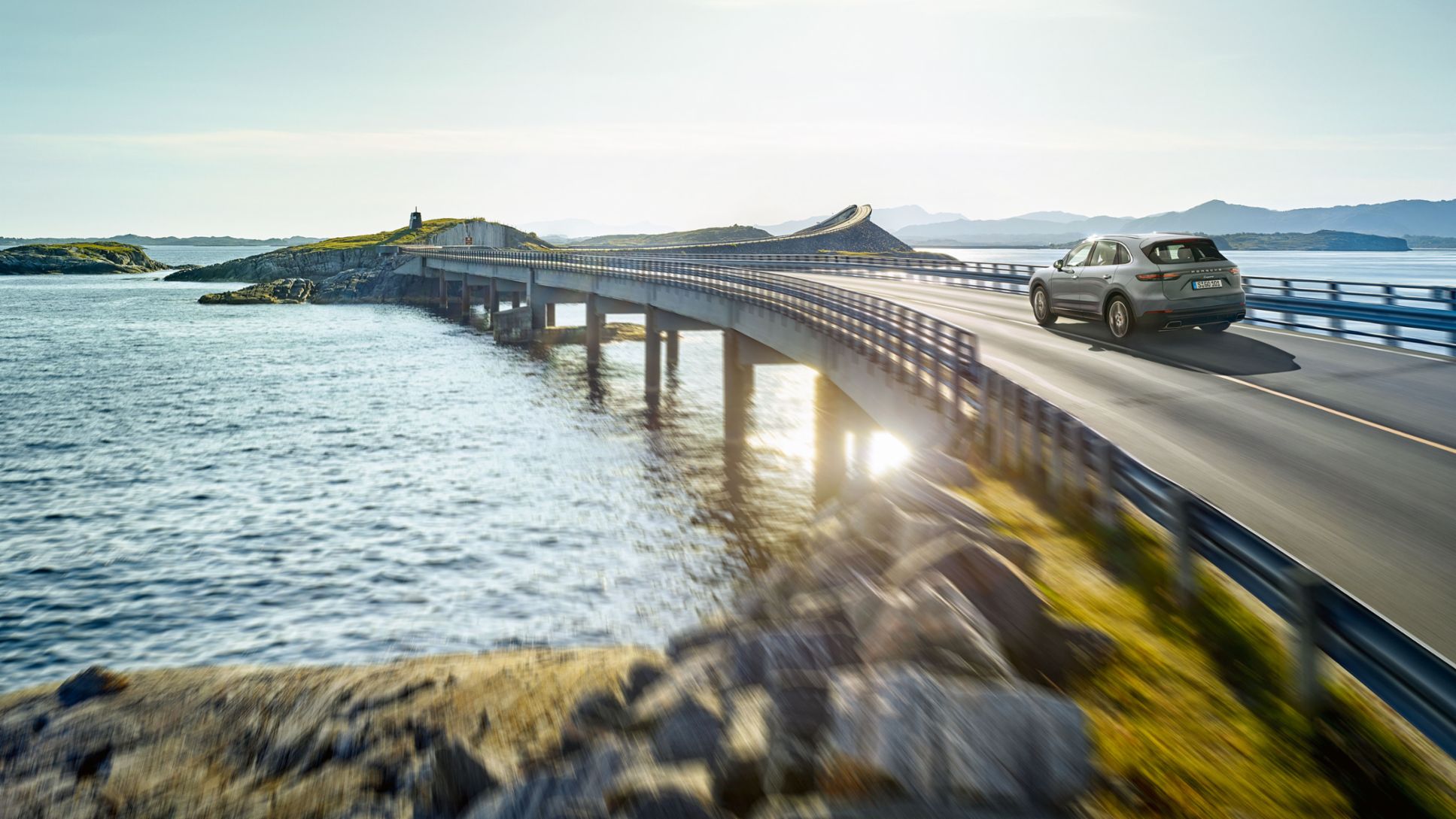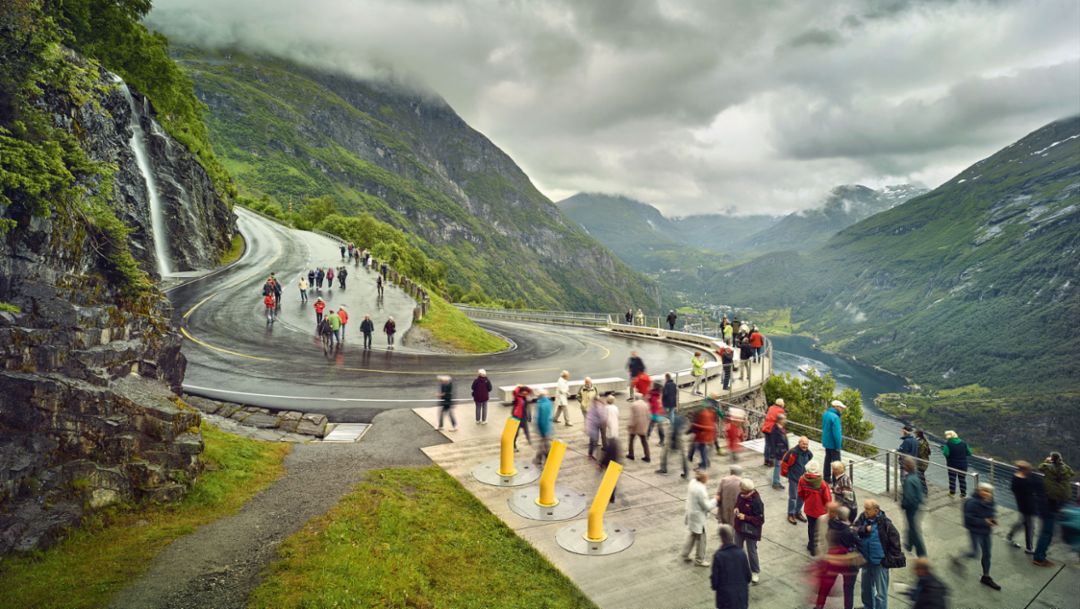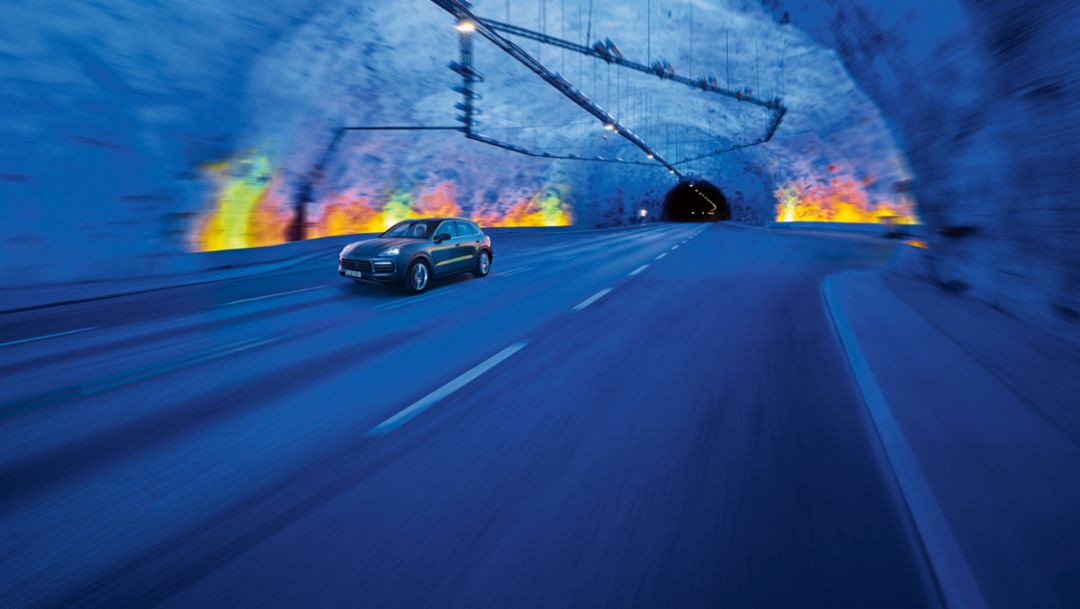It wends its way up the steep hillside like a thin, windblown ribbon: the famed Trollstigen, the Troll’s Path, Norway’s most popular scenic route and a masterpiece of engineering. Eleven hairpin turns between Isterdalen Valley and the Stigrøra pass, an elevation gain of 405 meters. In some places the road is cut right into the rock; in others, stone retaining walls support the structure. Halfway up to the pass, a stone bridge traverses the Stigfossen waterfall. Each of the bends has a name—most of them are named after the foremen of the construction crews that built the road.
It’s quite the ascent; stopping is all but impossible here, so bend by bend the Porsche Cayenne conquers the Trolltindene massif. Rock faces tower above like waves that never break. Here and there a huge waterfall plunges down to the valley, where the sea has cut a swathe one hundred kilometers deep into the interior: Geirangerfjord is Norway’s fjord of all fjords and a UNESCO World Heritage Site.
This jewel of Scandinavia is surrounded by mountains the size of cities, endless forests, snow-capped summits—and roads that people have managed to carve into that splendid natural environment. The band of asphalt rests in the wilds. Some 280 kilometers northwest of Oslo, the Porsche makes its way from Åndalsnes via Trollstigen to Geiranger, over the Golden Route opened by King Haakon VII in 1936. Scenic routes like this one are the centerpiece of Norway’s tourism. They provide access to the northern wilderness and pave the way to behold the diversity of the land. They remove the invisible barriers of the natural space.
Norway’s eighteen major scenic routes stretch over 1,850 kilometers between the mountains of the south and the Atlantic coast in the far north. These masterpieces of engineering, which unite the ageless beauty of nature with modern architecture, skirt fjords and meander through mountain ranges. Some of them even push right through the mighty waves of the Atlantic Ocean. The coastline, a jagged succession of fjords that would stretch to six thousand kilometers if pulled straight, presents no impediments for these roads.
Tight bends, broad landscapes
The Møre og Romsdal county is home to a large share of these kilometers-long asphalt drawings. Beyond the tight bends of Trollstigen, further inland, one of the country’s oldest roads climbs the mountain. Gamle Strynefjellsvegen has been there for nearly 130 years. Boundary stones mark the route, reminders of the early explorations of long-ago inhabitants. The region is highly popular among tourists, with the extraordinary juxtaposition of the possibility of swimming at the bottom and year-round snow at the top.
Today, the snow defies the sun yet again, though not without some effort—at 15 degrees Celsius, it’s the warmest day of the year so far. The road wends its way across the plateau from one picturesque mountain lake to another. For long stretches, turning around is all but out of the question; most of the time there’s not even space enough for two cars next to each other. The asphalt squeezes its way into the pristine landscape, in which scattered waterfalls stream through the stone like veins transporting the lifeblood of the land.
Back to nature means back to oneself. The Cayenne, too, brings forth its very best here. Offering space, creating space. The route leads into the mountain. Lærdalstunnelen, the longest road tunnel in the world. The waves of sound gather like rumbling thunder barreling down the cold, cave-like stone walls of the tunnel. It’s an extreme contrast to the quiet determination of the climbers on the mountain. Total expansiveness versus total limitation.
There’s not an overabundance of light over the 24.5 kilometers in the tunnel between Aurland and Lærdal in the county of Sogn og Fjordane. The Cayenne zips through the artificial twilight as if in a particle accelerator. Invisible to those outside. And almost invisible to those fellow travelers—temporary partners—in the tunnel, which is so many things at once: a connection, an incredible feat of engineering, modern architecture, and space.
Construction of the century
The Cayenne makes its way further northward to the Atlantic coast. Modern Norwegians’ forebears built large ships as far back as the Bronze Age. Thousands of years later, from 1983 to 1989, they created the Norwegian “construction of the century”: Atlanterhavsveien, the Atlantic Road. The 8,200-meter-long section of County Road 64 pays no mind to coastal boundaries. It plays with the unbridled ocean, tracing a nearly direct line between the cities of Molde and Kristiansund. It’s a road that embodies the belief that people are at their best where nature is at its wildest. The road crosses a number of bridges along the way, rising up to twenty-three meters above the raging sea. Accepting the challenge of nature, in the end, is what Norway’s National Tourist Routes are all about. The journey is the destination. The road is the art of getting there.
Atlanterhavsveien
Height: 23 meters
Construction period: 1983 – 1989
Length: 8,274 meters
The boundary between land and water has been erased. The Atlantic Road,
as Norway’s “construction of the century” is known in English, is among the most breathtaking roads in the world. Its bridges span a total of 891 meters.
Trollstigen
Elevation gain: 405 meters
Construction period: 1928 – 1936
Average gradient: 12 percent
Huge mountains with countless switchbacks surround the imposing Geirangerfjord, a UNESCO World Heritage Site since 2005 and one of the most familiar sights in Norway. The eleven most famous hairpin turns are found on Trollstigen: motorized climbing at its very best.
Gamle Strynefjellsvegen
Length: 27 kilometers
Construction period: 1881 – 1884
Highest point: 1,139 meters
One of the first mountain passes to accommodate horse-drawn carriages. Many of the original trail boundaries have weathered over the ages. Between the cities of Grotli and Videsæter travelers find practically everything nature has to offer in the region: grassy marshes and vast, ice-encrusted snowbanks.
Lærdalstunnelen
Length: 24.5 kilometers
Construction period: 1995 – 2000
Cost: approx. € 100 million
Total expansiveness versus total limitation. The world’s longest road tunnel between Aurlandsvangen and Lærdalsøyri is many things: a connection, a masterpiece of engineering, and a stunning example of modern architecture.
The new Porsche Cayenne
During this year’s International Motor Show in Frankfurt am Main, Porsche presented the third-generation Cayenne. It’s equipped with new engines, a new chassis, an innovative control concept, even more connectivity—and it weighs up to sixty-five kilograms less than its predecessor. For the first time, this sporty SUV is available with mixed tires and rear-axle steering. In addition, the active all-wheel drive, Porsche 4D Chassis Control system, three-chamber air suspension, and the Porsche Dynamic Chassis Control (PDCC) electric anti-roll system all improve the Cayenne’s on-road capabilities—without affecting its off-road suitability.
Info
Text first published in the Porsche customer magazine Christophorus, No. 383
Consumption data
Cayenne: Fuel consumption combined 9.2 – 9.0 l/100 km; CO2-emissions 209 – 205 g/km
Cayenne Turbo: Fuel consumption combined 11.9–11.7 l/100 km; CO₂-emissions 272–267 g/km
Cayenne S: Fuel consumption combined 9.4–9.2 l/100 km; CO₂-emissions 213–209 g/km





